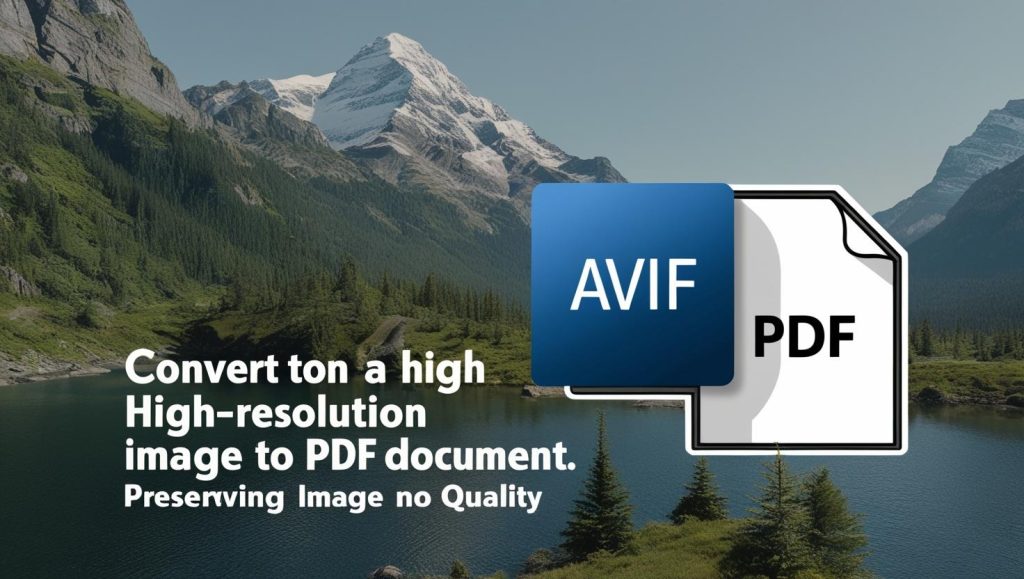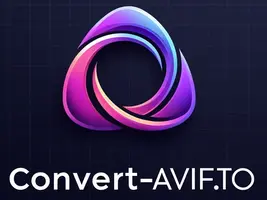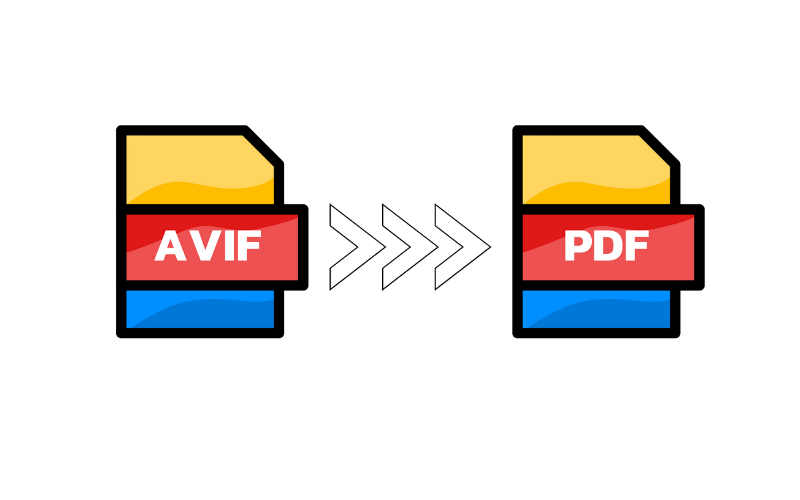In today’s digital landscape, image formats like AVIF are becoming increasingly popular. However, PDFs remain the go-to format for sharing and preserving documents due to their versatility and compatibility across various devices.
Convert AVIF to PDF can be a straightforward process with the right tools. This article will guide you through the process, highlighting the benefits of using PDFs and introducing you to reliable online converters.

Understanding AVIF and PDF Formats
The world of digital files is vast, with formats like AVIF and PDF serving distinct purposes. To effectively manage and utilize digital content, it’s essential to understand these formats.
What is AVIF?
AVIF is a relatively new image file format that utilizes the AV1 video codec for compression. It is designed to provide high-quality images at smaller file sizes compared to older formats like JPEG and PNG. AVIF supports both lossy and lossless compression, making it versatile for various applications, from web images to professional photography. One of the significant advantages of AVIF is its ability to maintain image quality while reducing file size, which is beneficial for web performance and storage efficiency.
What is a PDF?
A PDF, or Portable Document Format, is a file format used to present documents in a manner independent of application software, hardware, and operating systems. PDFs are widely used for sharing documents because they maintain the layout, formatting, and graphics of the original document, ensuring that the document looks the same on any device. PDFs can contain text, images, and other media, making them a comprehensive format for document exchange.
Key Differences Between AVIF and PDF
| Feature | AVIF | |
|---|---|---|
| Primary Use | Image compression | Document exchange |
| Compression Type | Lossy and lossless | Various, depending on content |
| Content Support | Images | Text, images, multimedia |
| Platform Independence | Yes, but less common | Highly supported |
| Editing Capabilities | Limited | Extensive, with PDF editors |
The table above highlights the key differences between AVIF and PDF formats. While AVIF excels in image compression, PDF is superior for document exchange and preservation. Understanding these differences is crucial for choosing the right format for specific needs, such as converting AVIF images to PDF for broader compatibility and sharing.
By grasping the fundamentals of AVIF and PDF, users can make informed decisions about file format conversions, such as converting Avif files to PDF, to suit their requirements for image quality, document integrity, and compatibility.
Why Convert AVIF to PDF?
The need to convert AVIF files to PDF arises from the versatility and compatibility of PDFs. PDFs are widely accepted across different platforms and devices, making them ideal for sharing and preserving documents.
One of the primary reasons for converting AVIF to PDF is to leverage the benefits that PDFs offer. Let’s explore these benefits in more detail.
Benefits of Using PDFs
PDFs offer several advantages over other file formats, including AVIF. Some of the key benefits include:
- Universal Compatibility: PDFs can be opened on any device, regardless of the operating system or software installed.
- Preservation of Formatting: PDFs preserve the layout, fonts, and formatting of the original document, ensuring that the content looks the same everywhere.
- Security Features: PDFs can be encrypted and password-protected, making them a secure choice for sensitive information.
- Ease of Sharing: PDFs are easy to share via email or online platforms, and they can be easily archived and stored.
According to a survey, “PDFs have become the standard for document exchange due to their reliability and consistency.”
“PDFs are the most trustworthy file format for exchanging documents because they maintain the formatting and layout of the original document.”
Common Use Cases for AVIF to PDF Conversion
There are several scenarios where converting AVIF to PDF is particularly useful. Some common use cases include:
| Use Case | Description |
|---|---|
| Document Archiving | Converting AVIF images to PDF for archiving purposes, ensuring that the documents are preserved in a consistent format. |
| Sharing Reports | Using PDFs to share reports that include AVIF images, ensuring that the layout and formatting are maintained. |
| Creating eBooks | Converting AVIF images to PDF for inclusion in eBooks, allowing for a more engaging reading experience. |
When looking for a tool to convert AVIF to PDF, consider using a free AVIF to PDF converter or the best AVIF to PDF converter available online. These tools can simplify the conversion process and ensure high-quality results.
Tools for Converting AVIF to PDF
Several tools are now available for converting AVIF files to PDF, catering to different user needs. Whether you’re looking for a quick online solution or a more comprehensive software package, there’s something for everyone.
Online Conversion Tools
Online conversion tools offer a convenient way to convert AVIF to PDF without the need for software installation. These web-based services are often free and easy to use.
- SmallPDF: Known for its user-friendly interface and high-quality conversions.
- Online-Convert: Offers a range of conversion options, including batch conversions.
While online tools are convenient, they often have limitations, such as file size restrictions and potential security concerns for sensitive documents.
Software Solutions for AVIF to PDF
For those requiring more advanced features or dealing with large files, desktop software is a viable option. These programs offer more control over the conversion process.
| Software | Key Features | Cost |
|---|---|---|
| Adobe Acrobat | Advanced PDF editing, high-quality conversions | Premium |
| Nitro PDF | Fast conversions, comprehensive PDF tools | Subscription-based |
Desktop software provides a robust solution for heavy users, offering greater flexibility and security.
Mobile Apps for Quick Conversion
For users on-the-go, mobile apps provide a quick and easy way to convert AVIF to PDF. These apps are available for both iOS and Android devices.
“Mobile apps have revolutionized the way we handle file conversions, offering unparalleled convenience.” – Tech Review
- PDF Converter (iOS, Android): Simple, intuitive interface for quick conversions.
- AVIF to PDF Converter (Android): Specialized app for AVIF conversions, offering batch processing.
Mobile apps are ideal for occasional conversions, providing a straightforward and accessible solution.
Step-by-Step Guide to Convert AVIF to PDF
Converting AVIF images to PDF format is a task that can be accomplished through various methods, each with its own set of advantages. Whether you’re looking to use an online tool for convenience or desktop software for more control, the process is relatively straightforward.
Using an Online Tool
Online tools offer a quick and easy way to convert AVIF to PDF without the need to install any software on your computer. To do this:
- Find a reliable online AVIF to PDF converter.
- Upload your AVIF file to the website.
- Select PDF as the output format.
- Adjust any available settings according to your preferences.
- Initiate the conversion process and wait for it to complete.
- Download the resulting PDF file.
Using online tools is convenient, especially for those who do not frequently convert file formats.
Converting with Desktop Software
For those who prefer or need to use desktop software, there are several applications available that can convert AVIF to PDF. Some popular options include image editing software and dedicated file conversion programs. To convert AVIF to PDF using desktop software:
- Open your chosen software and import the AVIF file you wish to convert.
- Look for an option to export or save the file in a different format.
- Select PDF as the output format.
- Adjust any relevant settings, such as quality or compression level.
- Save the file to your desired location.
Desktop software often provides more control over the conversion process, allowing for adjustments that can result in higher quality outputs.
Tips for Optimal Results
To achieve the best results when converting AVIF to PDF, consider the following tips:
- Quality Settings: Adjust the quality settings to balance between file size and image quality.
- Compression: Use compression options if available, to reduce the file size without significantly impacting quality.
- Metadata: If your software allows it, preserve the metadata of the original AVIF file during the conversion process.
Here’s a comparison table for different conversion methods:
| Conversion Method | Convenience | Quality Control | File Size Management |
|---|---|---|---|
| Online Tools | High | Low | Variable |
| Desktop Software | Medium | High | High |
By following these steps and tips, you can efficiently convert AVIF to PDF using the method that best suits your needs.
Best Practices for Converting AVIF to PDF
Best practices for converting AVIF to PDF involve a combination of ensuring high-quality output, managing file sizes, and preserving metadata. By following these guidelines, users can achieve optimal results when converting AVIF images to PDF documents.
Ensuring High Quality
To ensure high-quality output when converting AVIF to PDF, it’s essential to select the right conversion tool. Look for tools that support high-resolution outputs and maintain the original image quality. Some online tools, such as Online Convert and Convertio, offer advanced settings for adjusting the output quality.
When using desktop software for the conversion, options like Adobe Acrobat provide detailed settings for managing image quality during the conversion process. It’s also advisable to preview the output before finalizing the conversion to ensure it meets your quality standards.
Managing File Sizes
Managing file sizes is crucial, especially when dealing with large AVIF files. One effective strategy is to compress the AVIF images before converting them to PDF. Tools like TinyPNG and ImageOptim can significantly reduce the file size without compromising on quality.
Another approach is to use conversion tools that offer compression options. For instance, some online converters allow you to adjust the compression level, thereby controlling the final file size. It’s a balance between maintaining quality and achieving a manageable file size.
| Tool | Compression Option | Output Quality |
|---|---|---|
| Online Convert | Yes | High |
| Convertio | Yes | High |
| Adobe Acrobat | Yes | High |
Preserving Metadata
Preserving metadata during the AVIF to PDF conversion is vital for maintaining the integrity of the original files. Metadata includes information such as camera settings, date taken, and location. Some conversion tools automatically preserve this metadata, while others may require specific settings to be enabled.
“Metadata is crucial for image management and search functionality. Ensuring that this information is retained during file format conversions is essential for professionals who rely on this data.” –
When using online tools, check if they support metadata preservation. For desktop software, options like Adobe Acrobat and ExifTool provide features to retain metadata during the conversion process.
- Check the conversion tool’s settings for metadata preservation options.
- Use software that supports metadata retention, such as Adobe Acrobat.
- Verify the output PDF to ensure metadata is preserved.
By following these best practices, users can ensure a smooth and effective AVIF to PDF conversion process, maintaining the quality and integrity of the original images.
Troubleshooting Common Issues
While converting AVIF to PDF is relatively easy, some users may face challenges that need to be addressed. Understanding these common issues can significantly enhance the conversion experience.
Conversion Failures
Conversion failures can occur due to various reasons, including incompatible file formats or corrupted AVIF files. To avoid such issues, it’s essential to use a reliable AVIF to PDF converter that supports a wide range of file formats.
Some tips to prevent conversion failures include:
- Ensuring the AVIF file is not corrupted
- Using the latest version of the conversion software or tool
- Checking for any updates or patches for the conversion tool
Image Quality Issues
Maintaining image quality during the conversion process is crucial, especially when dealing with AVIF files that are known for their high compression efficiency. To ensure that the PDF output retains the quality of the original AVIF file, users should opt for a high-quality conversion tool.
Some strategies to maintain image quality include:
- Selecting the appropriate conversion settings that prioritize quality
- Avoiding excessive compression during the conversion process
- Using a conversion tool that supports high-resolution outputs
File Compatibility Problems
File compatibility issues can arise when the converted PDF file is not compatible with the intended software or hardware. To mitigate this, it’s advisable to choose a conversion tool that offers flexible output options, including the ability to select the PDF version.
To overcome file compatibility problems, consider the following:
- Checking the compatibility of the output PDF with the target software or device
- Adjusting the conversion settings to match the requirements of the intended use
- Using a conversion tool that provides options for customizing the output PDF
By understanding and addressing these common issues, users can ensure a smoother AVIF to PDF conversion process. For those looking for a hassle-free experience, using a free AVIF to PDF converter that is reliable and efficient can be a good starting point.
Additional Conversion Options
The versatility of AVIF files allows them to be converted into various formats, each serving a unique purpose. While converting AVIF to PDF is a common requirement, understanding other conversion options can be beneficial for different use cases.
AVIF to Other Formats
AVIF files can be converted into several other formats, including JPEG, PNG, and TIFF, depending on your needs. For instance, converting AVIF to JPEG is ideal when you need to share images on platforms that don’t support AVIF. Similarly, converting to PNG is useful when you require transparency in your images.
- JPEG: Ideal for sharing photos online where file size is a concern.
- PNG: Suitable for images that require transparency.
- TIFF: Preferred for high-quality prints or professional graphic design.
PDF Editing and Optimization Tools
After converting AVIF to PDF, you might need to edit or optimize the resulting PDF. There are several tools available that can help you achieve this. PDF editing tools allow you to modify the content, merge files, or add annotations, while optimization tools help in reducing file size without compromising quality.
Some popular PDF editing and optimization tools include:
- Adobe Acrobat: A comprehensive tool for editing, merging, and optimizing PDFs.
- Nitro PDF: Offers advanced editing features and high-quality output.
- SmallPDF: An online tool that provides easy-to-use PDF editing and compression options.
By leveraging these tools, you can ensure that your PDFs are not only converted from AVIF but are also optimized for their intended use, whether it’s for sharing, printing, or professional purposes.
Conclusion: Making the Switch from AVIF to PDF
Converting AVIF images to PDF format offers numerous benefits, including enhanced compatibility and versatility. By understanding the tools and best practices for conversion, users can efficiently make the switch.
Key Takeaways
The process of converting AVIF to PDF is streamlined with the use of online tools and software solutions. These converters enable users to maintain image quality while achieving the desired format.
Optimizing Your Conversion Process
To get the most out of converting AVIF to PDF, consider factors such as file size management and metadata preservation. Utilizing an Avif to PDF converter that supports these features can significantly enhance the conversion experience.
By choosing the right tools and following best practices, users can successfully convert AVIF files to PDF, leveraging the strengths of both formats. Whether for professional or personal use, this conversion process facilitates broader sharing and utilization of digital content.

